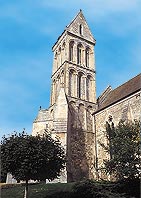 |
Soumont-Saint-Quentin (Canton of Falaise, Calvados) Saint-Quentin Church |
The Soumont-Saint Quentin Church is basically Gothic in style, although the lower part of the clock tower dates back to the end of the twelfth century, and remains essentially Roman.
The square side tower, built on the southern most section of the nave, rises up on four levels and is finished with a gable roof. Each level is clearly defined by a moulding, toric on the lower part and decorated with leaf-work on the third and on the cornice of the fourth. In the fifteenth or sixteenth century, the lower section of clock tower was reinforced with vast buttresses on the two southern angles. The first blind angle was pierced by an opening on its southern face in the Gothic periods. The second is ornamented with three blind arches. The arches are formed of regular point-work, in contrast with the wall, which is erratically decorated with stones on the first two levels of the tower. These arches are supported by cylindrical columns crowned with volute capitals. The arcades on the third level are higher and more ornate and also number three per side. The outer arches, decorated with two bands of chevrons, are bordered by the archivolts decorated with leaf-work. These rest on small capital columns with intermediary drop panels. The internal arches, fully recessed, also rest on small columns, although much narrower. The centre archways are pierced along their entire length by a narrow opening. The top level is Gothic. The broken arches are formed by several recessed arches, resting on two small columns. There are openings in each of the archways, forming two lancet arches separated by a small column.
The clock tower belongs to the Norman Roman family. The decoration and height of the levels increase progressively with the height of the tower, as do the openings, which also rise in number on the higher levels. The corners of the towers are adorned with small columns. It is the verticality which dates the clocks towers from the middle of the twelfth century, heralding the arrival of Gothic towers, although the different levels are clearly marked by horizontal mouldings. The Soumont-Saint Quentin tower dates from the end of the twelfth century, the upper archways already showing indications of the Gothic form.Bibliography
- Galeron, Statistiques de l'arrondissement de Falaise, Brée l'aîné, Falaise, s. d.
T. II, 5th book, pp. 167-168
- Caumont Arcisse (de), Statistique monumentale du Calvados, Hardel, Caen, 1859.
T. 4, p. 798 à 801